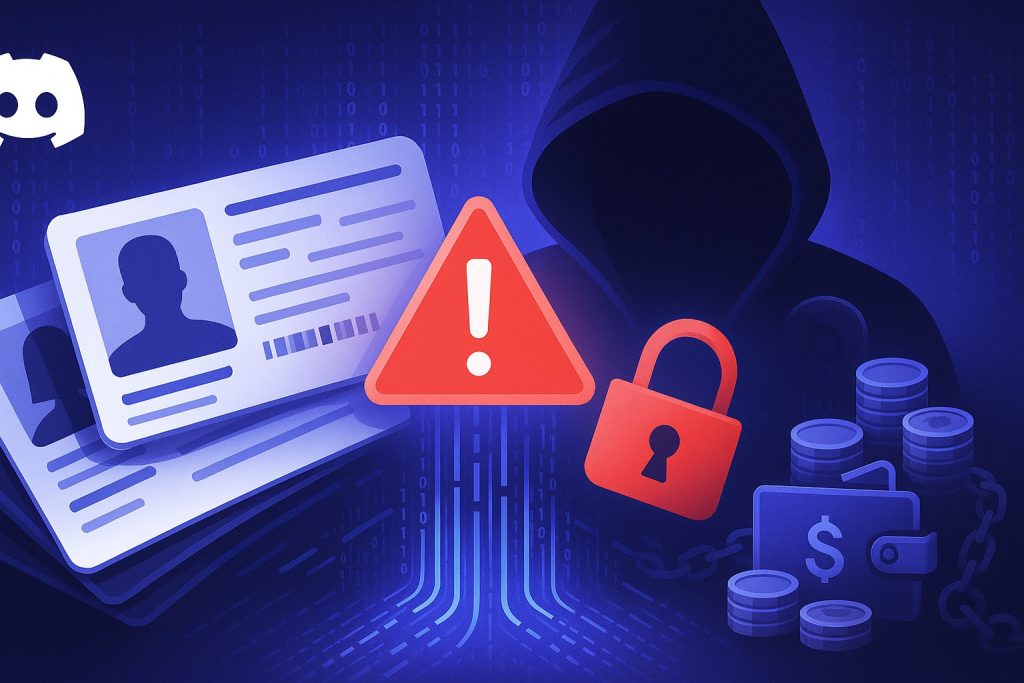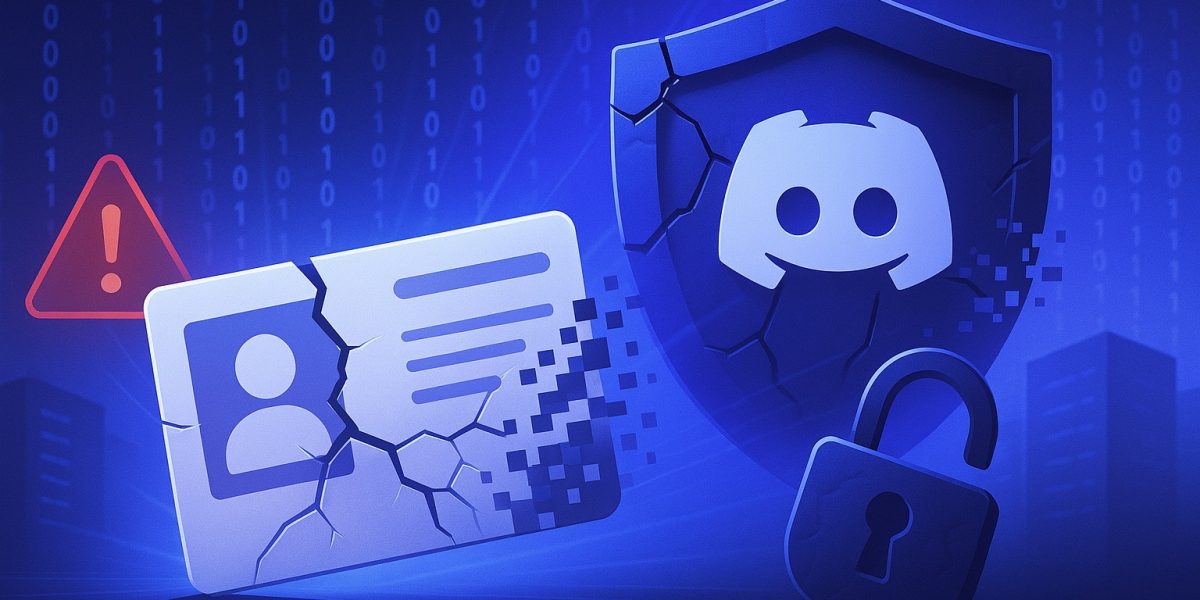A security incident at a third-party customer support vendor has exposed government-issued identification documents for approximately 70,000 Discord users, the messaging platform confirmed this week. Meanwhile, the attackers behind the breach are attempting to extort Discord with claims they’ve stolen far more data than the company acknowledges—threatening to release millions of additional documents if their ransom demands go unmet.
The breach occurred September 20, 2025, targeting a customer service provider Discord relies on rather than the platform’s own infrastructure. Discord, which serves over 200 million users globally, says its direct systems remained secure throughout the incident.

What Actually Got Compromised
The leaked data includes sensitive identity verification documents users submitted for age confirmation purposes. Beyond the ID photos themselves, the breach exposed names, email addresses, IP addresses, and the last four digits of credit card numbers for users who contacted Discord’s customer support.
Discord spokesperson Nhu Wexler told The Verge that all affected users worldwide have been notified. The company is working with law enforcement, data protection authorities, and security experts to address the situation.
The Extortion Campaign and Disputed Claims
A cybercriminal group calling itself “Scattered Lapsus$ Hunters” claimed responsibility for the attack and is now attempting to leverage inflated breach statistics to pressure Discord into paying. The hackers allege they stole 1.5 terabytes of data including more than 2.1 million government ID photographs, claiming they maintained access to Discord’s Zendesk customer support system for 58 hours starting September 20.
Discord flatly rejects these assertions. “The numbers being circulated are incorrect and part of an attempt to extort money from Discord,” Wexler stated. “We will not reward those responsible for their illegal actions.” The attackers reportedly demanded $3.5 million as ransom payment and threatened to publicly release stolen data after Discord refused negotiations.
Response Measures and Ongoing Investigation
Discord immediately revoked the compromised vendor’s access to its ticketing systems upon discovering the breach and initiated a comprehensive investigation with a leading computer forensics firm. The company hasn’t identified the specific third-party provider involved in the incident, though security researchers point to the Zendesk support platform as the compromised system.
The breach timeline matters because it reveals how quickly Discord detected and responded to unauthorized access. The 58-hour window the hackers claim—if accurate—represents the gap between initial compromise and Discord’s discovery and remediation. That’s not an exceptionally long detection time for vendor-based breaches, where monitoring is inherently more difficult than for directly controlled infrastructure.
Age Verification Requirements Create Data Risks
This incident has reignited debate around mandatory age verification laws requiring platforms to collect government identification documents. Critics argue that demanding such sensitive materials creates unnecessary risks when those documents get stored across multiple third-party systems—exactly what happened here.
Discord’s age verification process requires users flagged as potentially underage to provide photographs of themselves holding government-issued IDs. These documents were supposedly used exclusively for verification purposes before being deleted, though the breach suggests retention extended longer than users might expect.
The Verification Paradox:
Age verification laws aim to protect minors online, but they create honeypots of extremely sensitive personal data. Government IDs contain information useful for identity theft—full names, addresses, birth dates, ID numbers, and photographs. When platforms collect this material to comply with regulations, they become custodians of data worth significant money to cybercriminals.
The third-party vendor model compounds these risks. Discord doesn’t directly handle all support tickets—many platforms outsource customer service to specialized companies with teams across multiple countries. Each vendor in the chain represents another potential vulnerability, another set of employee credentials that could be compromised, another system that needs securing.
Ransom Demands and Public Data Threats
The $3.5 million ransom demand reflects the attackers’ assessment of the data’s value—both for extortion and potential resale. Identity documents command premium prices in underground markets where they enable account takeovers, fraudulent credit applications, and various identity theft schemes.
Discord’s refusal to negotiate represents standard guidance from law enforcement and security experts. Paying ransoms doesn’t guarantee data deletion, funds criminal operations that perpetuate attacks, and marks organizations as willing to pay—inviting future extortion attempts.
The hackers’ threat to publicly release data if demands aren’t met follows a familiar pattern in modern ransomware and data extortion campaigns. Attackers increasingly combine encryption attacks with data theft, giving them leverage even if victims can restore from backups. In Discord’s case, there’s no encryption component—just stolen data and threats of exposure.
Third-Party Risk Management Challenges
This breach highlights the persistent challenge of third-party security risk. Organizations can implement robust security controls for their own infrastructure while remaining vulnerable through vendors with weaker protections. Customer support platforms are particularly attractive targets because they aggregate sensitive information from across the entire user base.
Zendesk, if indeed the compromised system, serves thousands of companies handling support tickets containing personally identifiable information, payment details, and confidential communications. A breach affecting one Zendesk-using company could potentially expose data from many organizations if attackers gained broad access to the platform itself rather than just a single client’s instance.
Discord hasn’t clarified whether the breach affected the vendor’s systems broadly or specifically targeted Discord’s data. That distinction matters—a targeted attack suggests Discord was specifically chosen, while a broader vendor compromise might have swept up Discord data alongside other clients’ information.
User Impact and Notification Requirements
The 70,000 affected users represent a small fraction of Discord’s 200+ million user base, but the sensitivity of exposed data makes this significant. Government ID theft enables fraudsters to open financial accounts, file fraudulent tax returns, access government benefits, and conduct various identity fraud schemes.
Data protection regulations like GDPR in Europe and various state laws in the US impose notification requirements when personal data breaches occur. Discord’s global notification to affected users complies with these obligations, though the timeline between breach discovery and user notification wasn’t disclosed.
What Affected Users Should Do:
Anyone notified about this breach should monitor credit reports for unusual activity, consider fraud alerts or credit freezes, watch for phishing attempts exploiting leaked email addresses, and remain skeptical of communications claiming to be from Discord or government agencies—attackers often leverage breached data for targeted phishing campaigns.
The leaked IP addresses create additional risks by revealing users’ approximate locations and internet service providers—information useful for targeted attacks or harassment campaigns, particularly concerning for Discord users who participate in controversial communities or face online threats.

Age Verification Law Implications
This breach provides concrete evidence for arguments against mandatory identity document collection. Alternative age verification methods exist—credit card verification, knowledge-based authentication, or third-party age estimation services that don’t require storing identity documents.
Some jurisdictions are already implementing or considering laws requiring social media platforms to verify user ages, ostensibly to protect minors from harmful content. While well-intentioned, these laws create exactly the kind of centralized identity document repositories that become targets for sophisticated attackers.
The policy question becomes whether the protection offered by age verification outweighs the risks created by requiring platforms to collect and secure highly sensitive identity documents. This Discord breach demonstrates those risks aren’t theoretical—they materialize regularly despite organizations’ best security efforts.
Discord’s situation also illustrates how age verification requirements push smaller platforms toward third-party verification services since building secure identity verification infrastructure requires substantial investment. That consolidation creates systemic risks—breaches at major verification providers could expose data from hundreds of platforms simultaneously.
Whether this incident influences ongoing legislative debates around age verification remains to be seen. Policymakers face competing pressures: concerns about minors accessing inappropriate content versus privacy and security risks from collecting sensitive identity documents at scale. Discord’s breach provides fresh ammunition for the latter argument.




Post a comment